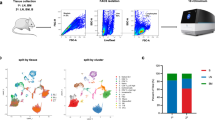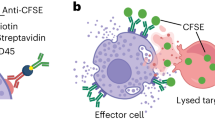Abstract
DATA on the T-cell antigens, Lyt 1, 2, 3 (refs 1, 2), relating to functional T-cell subsets, suggest that some peripheral T cells express restricted Lyt phenotypes, that is, Lyt 1+23− or Lyt 1−23+ (ref. 3). Evidence has been presented showing that two major subpopulations of lymphocytes, Lyt 1+ T cells and Lyt 23+ T cells, are committed to particular lines of functional differentiation in the immune response before encountering exogenous antigen in peripheral lymphoid tissue4,5. It has been suggested that the two major subpopulations representing T-cell help (Lyt 1+) and T-cell cytotoxicity or suppression (Lyt 23+) arise in the periphery from peripheral Lyt 123+ cells6. Recent studies have concluded that as stem cells mature in the thymus, the thymic epithelium is important in determining which H–2 specificities the maturing T cells are able to recognise as self7. Previous cytotoxicity data have been interpreted as indicating that Lyt 1, 2, 3 antigens are expressed on each of most if not all, mouse thymocytes; that is, that most thymocytes are Lyt 123+ (refs 1–4, 8–10). However, the data presented here suggest that the commitment to differentiation of the Lyt 1+ or the Lyt 123+ phenotype, and thus presumably the relevant functional differentiation occurs before cell migration from the thymus. Using flow microfluorometry (FMF) and anti-Lyt antisera, we demonstrate a normal thymocyte subpopulation which is not expressing Lyt 2 or Lyt 3 antigens (Lyt 1+23−). This subpopulation represents a significant constant proportion (10%) of normal thymocytes which is markedly increased following in vivo cortisone treatment. The data also show that Lyt 1 expression, rather than being decreased on cortisone-resistant thymocytes (CRT), as would have been predicted from previous cytotoxicity data2,8, is expressed in increased amounts on CRT.
This is a preview of subscription content, access via your institution
Access options
Subscribe to this journal
Receive 51 print issues and online access
$199.00 per year
only $3.90 per issue
Buy this article
- Purchase on Springer Link
- Instant access to full article PDF
Prices may be subject to local taxes which are calculated during checkout
Similar content being viewed by others
References
Boyse, E. A., Miyazawa, M., Aoki, T. & Old, L. J. Proc. R. Soc. B170, 175–193 (1968).
Boyse, E. A., Itakura, K., Stockert, E., Iritani, C. & Miura, M. Transplantation 11, 351–353 (1971).
Cantor, H. & Boyse, E. A. Immun. Rev. 33, 105–124 (1977).
Cantor, H. & Boyse, E. A. J. exp. Med. 141, 1376–1389 (1975).
Jandinski, J., Cantor, H., Tadakuma, T., Peavy, D. L. & Pierce, C. W. J. exp. Med. 143, 1382–1390 (1976).
Huber, B., Cantor, H., Shen, F. W. & Boyse, E. A. J. exp. Med. 144, 1128–1133 (1976).
Zinkernagel, R. M. et al. J. exp. Med. 147, 882–896 (1978).
Kisielow, P. et al. Nature 253, 219–220 (1975).
Mosier, D. E., Mathieson, B. J. & Campbell, P. S. J. exp. Med. 146, 59–73 (1977).
Kamarack, M. E. & Gottlieb, P. D. J. Immun. 119, 407–415 (1977).
Shen, F-W., Boyse, E. A. & Cantor, H. Immunogenetics 2, 591–595 (1975).
Morse, H. C. III, Neiders, M. E., Lieberman, R., Lawton, A. R. III & Asofsky, R. J. Immun. 118, 1682–1689 (1977).
Mathieson, B. J., Campbell, P. S., Potter, M. & Asofsky, R. J. exp. Med. 147, 1267–1279 (1978).
Loken, M. R. & Herzenberg, L. A. Ann. N. Y. Acad. Sci. 254, 163–171 (1975).
Miller, M. H., Powell, J. I., Sharrow, S. O. & Schultz, A. R. Rev. scient. Instrum. 49, 1137–1142 (1978).
Weissman, I. L., Small, M., Fathman, C. G. & Herzenberg, L. A. Fedn Proc. 34, 141–144 (1975).
Boyse, E. A., Old, L. J. & Stockert, E. Immunopath. Int. Symp. 4th, 23–40 (1965).
Tigelaar, R. E., Gershon, R. K. & Asofsky, R. Cell. Immun. 19, 58–64 (1975).
Shiku, H. et al. J. exp. Med. 141, 227–241 (1975).
Schlager, S. I., Ohanian, S. H. & Borsos, T. J. Immun. 120, 463–471 (1978).
Beverley, P. C. L., Woody, J., Dunkley, M., Feldman, M. & McKenzie, I. Nature 262, 495–497 (1976).
Author information
Authors and Affiliations
Rights and permissions
About this article
Cite this article
MATHIESON, B., SHARROW, S., CAMPBELL, P. et al. An Lyt differentiated thymocyte subpopulation detected by flow microfluorometry. Nature 277, 478–480 (1979). https://doi.org/10.1038/277478a0
Received:
Accepted:
Issue Date:
DOI: https://doi.org/10.1038/277478a0
This article is cited by
-
Distribution of Lyt antigens on the surface of thymocytes associated with thymic macrophages and dendritic cells
Histochemistry (1988)
-
Lewis lung carcinoma (3LL) cells treated in vitro with ultraviolet radiation show reduced metastatic ability due to an augmented immunogenicity
Clinical & Experimental Metastasis (1987)
-
Temporal changes of suppressor T lymphocytes and cytotoxic T lymphocytes in syngeneic murine malignant gliomas
Journal of Neuro-Oncology (1986)
-
Immunofluorescent flow cytometry inN dimensions
Cell Biophysics (1985)
-
Intrathymic differentiation: Thymocyte heterogeneity and the characterization of early t-cell precursors
Survey of Immunologic Research (1985)
Comments
By submitting a comment you agree to abide by our Terms and Community Guidelines. If you find something abusive or that does not comply with our terms or guidelines please flag it as inappropriate.



